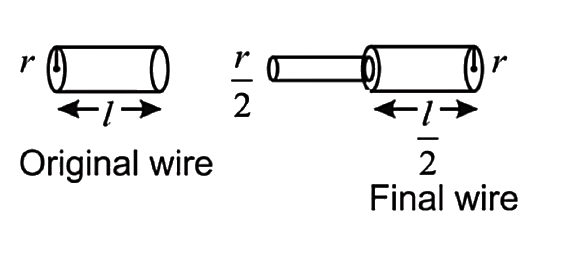A metal wire of circular cross-section has a resistance R1. The wire is now stretched without breaking, so that its length is doubled and the density is assumed to remain the same. If the resistance of the wire now becomes R2, then R2:R1 is
1:1
1:2
4:1
1:4
The correct Answer is:C
To solve the problem, we need to analyze the relationship between the resistance of a wire before and after it is stretched.
1. Understand the Initial Conditions:
- Let the initial length of the wire be L.
- Let the initial cross-sectional area be A.
- The initial resistance of the wire is given by:
R1=ρLA
where ρ is the resistivity of the material.
2. Determine the New Length and Area After Stretching:
- The wire is stretched to double its length, so the new length L′ is:
L′=2L
- The density of the wire remains constant. Therefore, the mass before stretching is equal to the mass after stretching:
m1=m2
- The mass can be expressed as:
m=density×volume
- Initially, the volume V1 is:
V1=A×L
- After stretching, the volume V2 becomes:
V2=A′×L′=A′×2L
- Setting the two volumes equal (since mass is constant):
A×L=A′×2L
- Canceling L from both sides:
A=2A′
- Therefore, the new cross-sectional area A′ is:
A′=A2
3. Calculate the New Resistance:
- The new resistance R2 after stretching is given by:
R2=ρL′A′
- Substituting L′ and A′:
R2=ρ(2L)A/2
- Simplifying this:
R2=2ρLA×2=4ρLA
- We know from the initial resistance:
R1=ρLA
- Therefore, substituting R1 into the equation for R2:
R2=4R1
4. Find the Ratio of Resistances:
- The ratio of the new resistance to the old resistance is:
R2R1=4
- Thus, we can express this as:
R2:R1=4:1
Final Answer:
The ratio R2:R1 is 4:1.
- Let the initial length of the wire be L.
- Let the initial cross-sectional area be A.
- The initial resistance of the wire is given by:
R1=ρLA
where ρ is the resistivity of the material.
- The wire is stretched to double its length, so the new length L′ is:
L′=2L
- The density of the wire remains constant. Therefore, the mass before stretching is equal to the mass after stretching:
m1=m2
- The mass can be expressed as:
m=density×volume
- Initially, the volume V1 is:
V1=A×L
- After stretching, the volume V2 becomes:
V2=A′×L′=A′×2L
- Setting the two volumes equal (since mass is constant):
A×L=A′×2L
- Canceling L from both sides:
A=2A′
- Therefore, the new cross-sectional area A′ is:
A′=A2
- The new resistance R2 after stretching is given by:
R2=ρL′A′
- Substituting L′ and A′:
R2=ρ(2L)A/2
- Simplifying this:
R2=2ρLA×2=4ρLA
- We know from the initial resistance:
R1=ρLA
- Therefore, substituting R1 into the equation for R2:
R2=4R1
- The ratio of the new resistance to the old resistance is:
R2R1=4
- Thus, we can express this as:
R2:R1=4:1
The ratio R2:R1 is 4:1.
Topper's Solved these Questions
- CURRENT ELECTRICITYBOOK - DC PANDEY ENGLISHCHAPTER - CURRENT ELECTRICITYEXERCISE - Match the columns
4 Videos
- COMMUNICATION SYSTEMBOOK - DC PANDEY ENGLISHCHAPTER - COMMUNICATION SYSTEMEXERCISE - Subjective
11 Videos
- ELECTROMAGNETIC INDUCTIONBOOK - DC PANDEY ENGLISHCHAPTER - ELECTROMAGNETIC INDUCTIONEXERCISE - Medical entrances gallery
25 Videos
Similar Questions
If a wire is stretched to double its length, find the new resistance if the original resistance of the wire was R.
View SolutionA wire has a resistance R. What wil will be its resistance if it is stretched to double its length?
View SolutionThe resistance of a wire R Ω . The wire is stretched to double its length keeping volume constant. Now, the resistance of the wire will become
View SolutionA wire of resistance 4Ω is stretched to twice its original length. In the process of stretching, its area of cross-section gets halved. Now, the resistance of the wire is
View SolutionA wire is stretched to n times its length. Then the resistance now will be increase by
View SolutionIf a wire of resistance R is melted and recasted in to half of its length, then the new resistance of the wire will be
View SolutionA metal wire of resistance 6Ω is stretched so that its length is increased to twice its original length. Calculate its new resistance.
View SolutionA wire has a resistance R. What will be its resistace if (a) it is double on itself and (b) it is stretched so that (i) its length is double and (ii) its radius is halved.
View SolutionWhen a wire is stretched and its radius becomes r/2 then its resistance will be
View SolutionA wire of length l has a resistance R. If half of the length is stretched to make the radius half of its original value, then the final resistance of the wire is

View Solution
